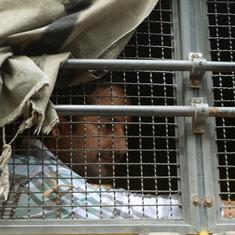Mamta Kol has been eating chapati and salt at least two or three times a week ever since her husband lost his job two years ago following the Covid-19 lockdown in March 2020. The 32-year-old mother of two weighs only 40 kg and often misses her menstrual period due to weakness.
Though community health workers who visit Kol’s village Kothar in Rewa district of Madhya Pradesh have told her to include milk and fruits in her diet, she continues to eat the bare minimum – leftovers after feeding her husband and their two sons aged 10 and seven.
“I find it tragically hilarious that these workers ask me to drink milk and eat fruit every day,” said Kol. “There were days when my family had to sleep on an empty stomach.”
Her husband Ramchandra Kol used to work at a factory that made plastic sacks in Ahmedabad. In March 2020, when a nationwide lockdown was announced, Ramchandra’s factory stopped operations and he had to walk for seven days to get back home to his village. More than two years later, though normalcy has been restored, Ramchandra does not dare go back. He now works for daily wages at construction sites in the area.
The same story is playing out in other villages in the area. At least 90% of the men used to migrate seasonally to other cities and states for work. But since the first wave of Covid-19 hit, hardly any of them do this anymore.
Ramchandra Kol now manages to find work once in four days on average. This has directly affected the quantity and quality of food on his family’s table. With inflation soaring, the family cooks simple meals of dal and rice or vegetable and chapatis, but even then, there isn’t not enough for all of them. By the time it is Mamta Kol’s turn to eat, there is hardly any dal or vegetable left.
Ram Naresh, district coordinator with the Right to Food Campaign,said that during the pandemic many tribal families received free cereals and help from the government, non-profit and civil society organisations. The Right to Food Campaign is an informal network of individuals and organisations that work to help ensure the implementation of the right to food in India.
“The real problem now is men are not returning to [or not being asked to] work, and, in the fear of another such lockdown, not using all of their little earnings on food,” he said. “This poor diet coupled with Covid-19 stress has led to a shift in the general nutritional profile.”
Food in the family
Women in the average Indian household are largely responsible for cooking and putting food on the table. As they ensure that everyone is fed well, they are usually the last to eat. In a food-insufficient environment, this means a poor diet mostly consisting of leftovers.
Dipa Sinha, economist and lead campaigner with the Right to Food Campaign, said the distress caused by the initial lockdown has intensified. During the two waves of the pandemic in India in 2020 and the summer of 2021, the Right to Food Campaign conducted Hunger-Watch surveys.
“Two years of post-Covid distress has exhausted most families’ financial back-ups, thus reducing the variety of food on the table,” said Sinha. “Combined with less access to nutrition, women’s health has been more impacted than men’s.”
There are many factors that influence differences in the way food is allocated within households, including income disparity, social status and relationships. But the most important is the role of women in a household where they eat only after everyone else has.

Soumya Gupta, a research economist at the Tata-Cornell Institute, who co-authored studies on Covid-19 and women’s nutrition, said that physiologically, the nutritional needs of women differ from men.
“Depending on the stage of the life-cycle, adolescent girls, and women who are menstruating, pregnant or lactating have greater nutritional requirements,” said Gupta. “This needs to be placed in the context of the dietary gap that has already persistently marked women’s food consumption.”
She added: “During the pandemic, this gap has likely worsened – and is unlikely to be distributed equally/evenly amongst members of the same household – thereby affecting women’s nutritional status more adversely, as compared to men.”
Food insufficiency, high cost
A daily, diverse diet rich in protein, vitamins, and minerals ensures a nutritious lifestyle. A healthy diet also helps build a stronger immune system and promotes recovery from illnesses.
But during the pandemic, the disruptions to food supply chains coupled with significant income loss as many lost their jobs led to a crisis in food security and sufficiency.
The supply chain troubles drive up prices, making basics unaffordable for many.
A 2021 study by the Tata-Cornell Institute for Agriculture and Nutrition found that during the pandemic there was a significant decline in household food expenditures, particularly on a diverse diet and especially non-staples that are rich in proteins and key micronutrients.
Researchers found that the average Indian’s diet costs roughly $1 or approximately Rs 80 per day, which is much lower than the “least-expensive healthy diet recommended by the Eat-Lancet Commission” of $3-$5 (Rs 240-Rs 400) per person per day.
According to Gupta, free food rations provided through the public distribution system only ensured calorie sufficiency and prevented an increase in hunger levels. But micronutrient malnutrition is thought to have increased. The World Health Organization says micronutrients are vitamins and minerals required by the body in small amounts but that are crucial to staying healthy.
“We make this distinction between calories and micronutrients to drive home the point that even if calorie security was ensured, nutrition insecurity was exacerbated during the pandemic,” said Gupta.
#AatmanirbharBharatKaBudget announcement of Mission POSHAN 2.0 amalgamating Supplementary Nutrition Program & POSHAN Abhiyan will focus on overall health-wellbeing of beneficiary. Integrated approach in delivery of nutrition services will reinforce the fight against malnutrition.
— Smriti Z Irani (@smritiirani) February 1, 2021
She added that nutrition insecurity was also reflected in the significant decline in women’s diet diversity. The researchers found that the diet diversity of women in 2020 was significantly lower than in 2019, and fewer women were consuming protein-rich dairy foods and Vitamin A-rich fruits and vegetables, as well as other nutritious food.
The National Family Health Survey-5 released in November last year showed that the overall nutritional profile of Indian women and children had decreased since the 2015-’16 survey. The fifth round of the survey was conducted between 2019 to 2021.
The report showed that the percentage of anaemic women rose to 57% from 53.1% and anaemic teenage girls (15-19 years of age) to 59.1% from 54.1%. This huge shift in the nutrition profile clearly indicated that women’s health was directly affected by their socioeconomic conditions.
The survey also showed that the number of anaemic children under five years of age rose to 67.1% from 58.6% in the last survey. This meant that two out of every three children under five years of age in India are anaemic. In the same age group, the percentage of overweight children increased from 2.1% to 3.45%, meaning that their diet was cereal-centric and processed-food heavy.
What can be done?
Experts emphasise the importance of government policies that aim to ensure nutrition security keeping women’s nutritional requirements in mind. For example, the public distribution system can provide nutrient-rich non-staples, Aanganwadi centres can supply micronutrient-rich alternatives and schools can provide high-protein mid-day meals.
Despite the overflowing stocks of wheat and other cereals in government godowns during the lockdowns, it was the distribution system that was a problem, said Sinha.
According to Gupta, major market reforms and distribution systems can remove supply-side bottlenecks. “An expansion of direct benefit transfers can ensure households have access to and can afford healthy foods from local markets,” said Gupta.
For now, Naresh and his team of the Right to Food Campaign are working to help local residents understand the importance of growing their own food. With their help, some families, including Kol’s, have started growing daily vegetables in small patches outside their homes.
While this has helped, there is still not enough for the entire family. “I have started growing some vegetables near the pond, but that’s not enough for all four of us,” said Mamta Kol. “My foremost duty is to ensure that my husband and children are fed.”
Cheena Kapoor is a Delhi-based independent journalist and photographer focusing on health and social issues. Her Twitter handle is @cheenakapoor.
This article was made possible by a grant from the Thomsons Reuters Foundation.










